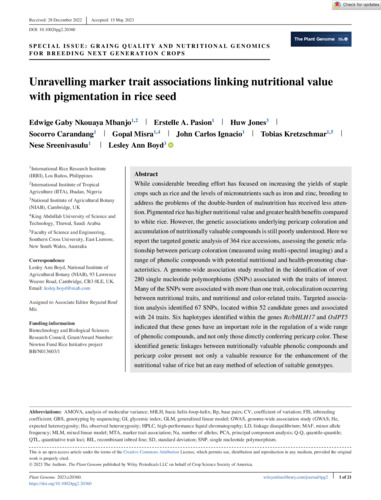Unravelling marker trait associations linking nutritional value with pigmentation in rice seed
Abstract
While considerable breeding effort has focused on increasing the yields of staple crops such as rice and the levels of micronutrients such as iron and zinc, breeding to address the problems of the double-burden of malnutrition has received less attention. Pigmented rice has higher nutritional value and greater health benefits compared to white rice. However, the genetic associations underlying pericarp coloration and accumulation of nutritionally valuable compounds is still poorly understood. Here we report the targeted genetic analysis of 364 rice accessions, assessing the genetic relationship between pericarp coloration (measured using multi-spectral imaging) and a range of phenolic compounds with potential nutritional and health-promoting characteristics. A genome-wide association study resulted in the identification of over 280 single nucleotide polymorphisms (SNPs) associated with the traits of interest. Many of the SNPs were associated with more than one trait, colocalization occurring between nutritional traits, and nutritional and color-related traits. Targeted association analysis identified 67 SNPs, located within 52 candidate genes and associated with 24 traits. Six haplotypes identified within the genes Rc/bHLH17 and OsIPT5 indicated that these genes have an important role in the regulation of a wide range of phenolic compounds, and not only those directly conferring pericarp color. These identified genetic linkages between nutritionally valuable phenolic compounds and pericarp color present not only a valuable resource for the enhancement of the nutritional value of rice but an easy method of selection of suitable genotypes.

